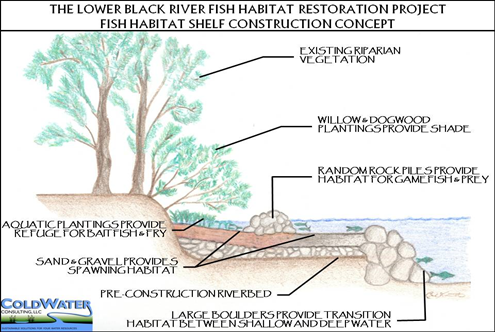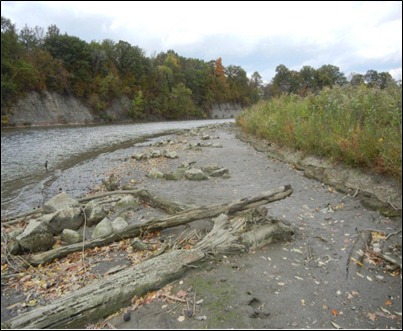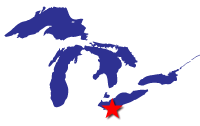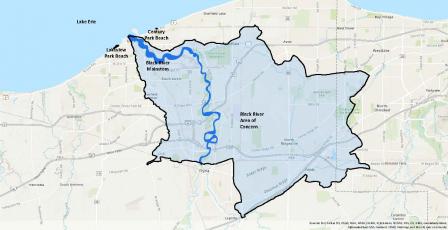Black River AOC
Locate It
Contact Us
Kristen Isom
(isom.kristen@epa.gov)
312-353-6318
Latest News
EPA reaches milestone of restoring 100 beneficial uses at various Great Lakes Areas of Concern
Overview
Located west of Cleveland in Northern Ohio, the Black River watershed drains into Lake Erie near the city of Lorain. The Black River was once nicknamed the “river of fish tumors” due to its long history of industrial, agricultural, and urban uses, which led to poor water quality, loss of biodiversity, habitat degradation, and sedimentation. Environmental impacts became severe enough for the river to be designated as an Area of Concern (AOC) in 1987.
Historically, the city of Lorain relied on the river for bringing materials to and from its once prosperous industrial center. The river was used as a mode of commerce and was degraded by discharges from industrial operations and wastewater, which contributed to heavy metal and polynuclear aromatic hydrocarbon (PAH) contamination. Other events that played a role in the river’s impairments include:
- Municipal discharges
- Bank erosion
- Commercial and residential development
- Atmospheric deposition of contaminants
- Hazardous waste disposal sites
- Urban stormwater runoff and combined sewer overflows
- Agricultural runoff from the upper watershed
The Black River AOC encompasses the entire 74 square mile watershed, including:
- The entire Black River mainstem from the city of Lorain to the city of Elyria.
- The French Creek Watershed.
- The Outer Harbor area, located between the east and west shore-arms in Lake Erie.
- The nearshore area of Lake Erie including two Lake Erie Beaches: Century Park Beach, located east of the river mouth; and Lakeview Park Beach, located west of the river mouth.
The river provides drinking water for two communities and high-quality aquatic habitat for seven state-listed endangered, threatened or special concern aquatic animal species, including the piping plover, and 12 state-listed endangered, threatened or special concern plant species.
Beneficial Use Impairments
Beneficial Use Impairments, or BUIs, are designations given by the International Joint Commission for an AOC. They recognize various examples of significant environmental degradation. As restoration and cleanup projects make progress, monitoring at the site can show recovery in environmental health. If sufficient recovery is reached, BUIs can be designated as “removed.”
The Restrictions on Dredging Activities BUI is projected for removal in 2021. The list below is comprehensive of all BUIs identified at the Black River AOC. In total, three BUIs have been removed from the AOC. Changes in this section to reflect the removal of the Degradation of Aesthetics BUI.
Once Fish Tumors or Other Deformities monitoring results confirm the rates are no higher than non-AOC control sites, this BUI can also be removed. When all BUIs below have been removed, the process of delisting the AOC can begin.
- Restrictions on Fish and Wildlife Consumption - Removed 2017
- Eutrophication or Undesirable Algae - Removed 2017
- Degradation Fish and Wildlife Populations
- Beach Closings
- Fish Tumors or Other Deformities
- Degradation of Aesthetics- Removed 2021
- Degradation of Benthos
- Restriction on Dredging Activities
- Loss of Fish and Wildlife Habitat
- General information about BUIs: Beneficial Use Impairments for the Great Lakes AOCs
- To view the status of each BUI for this AOC, see the Delisting Guidance and Restoration Targets for Ohio .
Restoration Work
Under a consent decree from U.S. EPA, U.S. Steel dredged 50,000 cubic yards of PAH-contaminated sediment near the company’s coking complex from 1989 to 1990. Since then, EPA and partners have worked to restore the AOC by identifying six habitat restoration management actions. As of 2020, all six of these management actions are complete. Work completed as part of these management actions included installing fish shelves, restoring and constructing wetland, and restoring native streambank vegetation, among other projects. The success of these projects will continue to improve plant and animal populations, help remove BUIs, and contribute to the eventual delisting of the AOC. As the AOC becomes closer to delisting, the city of Lorain and the surrounding area will continue to see ecological benefits of a healthy environment and likely the economic benefits that result from an accessible, healthy waterfront. Because of these efforts, those who live in the area have the potential to see an improved overall quality of life tied to restored local natural resources.
Highlighted Habitat Restoration Work
Lower Black River Heron Rookery Restoration
 Diagram of fish shelf construction using “build-out” technique.
Diagram of fish shelf construction using “build-out” technique.
The Great Lakes Restoration Initiative (GLRI) funded three habitat restoration projects to restore Black River stream and upland habitat. These projects benefitted a nearby 300-nest colony of Great Blue Herons, known as a rookery. A steel mill adjacent to the Black River caused environmental degradation and had the potential to impact fish and other wildlife in the Black River. By restoring and removing contaminants from the upland habitat, the projects prevented contamination runoff into the river, and ensured a safe food source for the herons. The projects also restored degraded habitat for fish and other wildlife in the river. Innovative construction techniques and careful attention to nesting windows ensured protection of the herons during construction.
- The first project removed 45,000 cubic yards of upland slag, a steel-making byproduct, to prevent contamination runoff into the Black River. Invasive species were removed, and native species were planted in the upland area. Additionally, 2,800 linear feet of fish shelves were created in the river to provide spawning habitat and refuge for aquatic life.
- The second project removed additional slag and restored approximately 4 acres of Black River floodplain. Over 1,500 native shrubs and trees were planted, and the site was restored in a way that imitates the floodplain habitat of the heron rookery.
- The last component of the restoration created an additional 1,400 linear feet of riverbank restoration. Innovative stream bank “build-out” techniques restored eroded, vertical banks along the heron rookery.
 Fish shelf at low water.These three restoration projects totaled $2.7 million of work and spanned 5 years. The heron rookery is thriving since the completion of these restoration projects.
Fish shelf at low water.These three restoration projects totaled $2.7 million of work and spanned 5 years. The heron rookery is thriving since the completion of these restoration projects.
The above projects target the following BUIs:
- Degraded Fish and Wildlife Populations
- Loss of Fish and Wildlife Habitat
- Degradation of Benthos
Partners
The following links exit the site Exit


